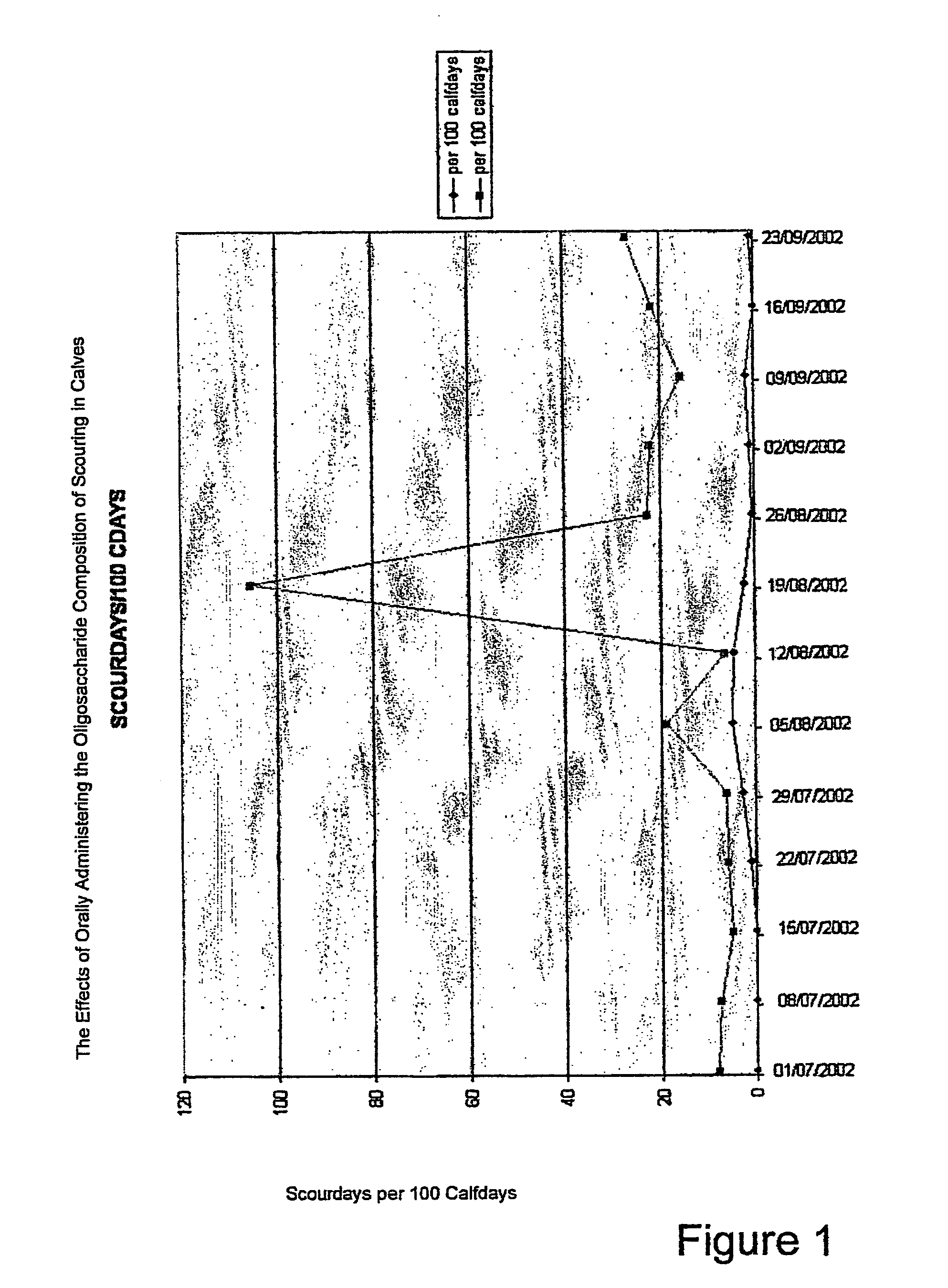Compositions and methods for animal treatment
a technology applied in the field of compositions and methods for animal treatment, can solve the problems of animal death, high cost of methods, cross infection of human population, etc., and achieve the effect of assisting in the improvement of the health and production of ruminant animals
- Summary
- Abstract
- Description
- Claims
- Application Information
AI Technical Summary
Benefits of technology
Problems solved by technology
Method used
Image
Examples
example 1
Bovine Calf Initial Trials
[0090]Random groups of new born bovines were selected to provide a cross population of animals likely to be exposed to a range of infection risk. Gluco-oligosaccharide (“GOS”) at an amount of 20 g per day was included in food regimes and the animals monitored for signs of infective diarrhea. A control group study without the added gluco-oligosaccharide in the food regime was also similarly monitored.
[0091]The study of newborn calves was to determine if enteral dosing would reduce the occurrence of diarrhea. An increase in the rate of survival of the study population would be an outcome and improved weight gain of the animals a term result The results are reported in Table 2.
[0092]
TABLE 2Group 1Control 1Group 2Control 2Number of75115180180calvesAge of calves+4 days +4 days+4 days +4 daysDosage rate20 g / dayNil30 g / dayNilNumber of calves7 / 9.3%55 / 47.8%2 / 1.1%22 / 12.2%with diarrheaFatalities2 / 2.6%13 / 11.3%1 / 0.6% 5 / 2.8%
[0093]The calves in the Group 1 study were hou...
example 2
Bovine Calf Field Trials
[0097]A group of 15 farms comprising a mix of calf rearers, dairy farmers and dairy beef farmers were supplied with an oligosaccharide composition consisting of enzymatically hydrolysed dextrin including approximately between 1.5 and 3% of the total mixture as isomalto-oligosaccharide and the remainder largely gluco-oligosaccharide, as described by the properties set out in Table 3.
[0098]
TABLE 3PropertyCharacteristicDextrose Equivalent50Degree of PolymerisationDP10.2%DP20.8%DP 31.5%DP 41.7%DP 51.8%DP 62.3%DP 72.7%DP 82.3%DP 91.9%DP10-2027.9% DP > 20 57%Molecular Weight>5000-6000Alcohol Insoluble Fibres % DS% Glucosidic Linkages(1-4) 50-64(1-6) 20-25(1-2) 7-10(1-3) 9-11Glucose % 0.5%Maltose 1.0%Oligo / Poly98.5%
[0099]The farms were in diverse locations to provide a random cross section of conditions. A total number of 2963 calves were monitored. The feeding of newborn calves remains a universally similar method in the first few weeks of life.
[0100]A group of 5 f...
example 3
Bovine Lactating Adult Initial Trials
[0111]Random groups of adult bovines were selected to provide a cross population of animals likely to be exposed to a range of infection risk. Gluco-oligosaccharide (“GOS”) at an amount of 20 g per day was included in food regimes and the animals monitored for signs of infective diarrhea. A control group study without the added gluco-oligosaccharide in the food regime was also similarly monitored.
[0112]The study of adult lactating cows was to determine if enteral dosing with functional carbohydrate would improve milk yield per animal as a consequence of increased digestive function and reduced infective diarrhea. Functional carbohydrate as used in Example 1 was given to the cows in group 1 by direct drenching. Functional carbohydrate as used in Example 1 was given to the cows in group 2 by addition to the cows' water supply using a Dosetron system. Daily milk production per animal measured for each group. The results are reported in Table 4.
[0113...
PUM
| Property | Measurement | Unit |
|---|---|---|
| temperature | aaaaa | aaaaa |
| thermostable | aaaaa | aaaaa |
| composition | aaaaa | aaaaa |
Abstract
Description
Claims
Application Information
 Login to View More
Login to View More - Generate Ideas
- Intellectual Property
- Life Sciences
- Materials
- Tech Scout
- Unparalleled Data Quality
- Higher Quality Content
- 60% Fewer Hallucinations
Browse by: Latest US Patents, China's latest patents, Technical Efficacy Thesaurus, Application Domain, Technology Topic, Popular Technical Reports.
© 2025 PatSnap. All rights reserved.Legal|Privacy policy|Modern Slavery Act Transparency Statement|Sitemap|About US| Contact US: help@patsnap.com



